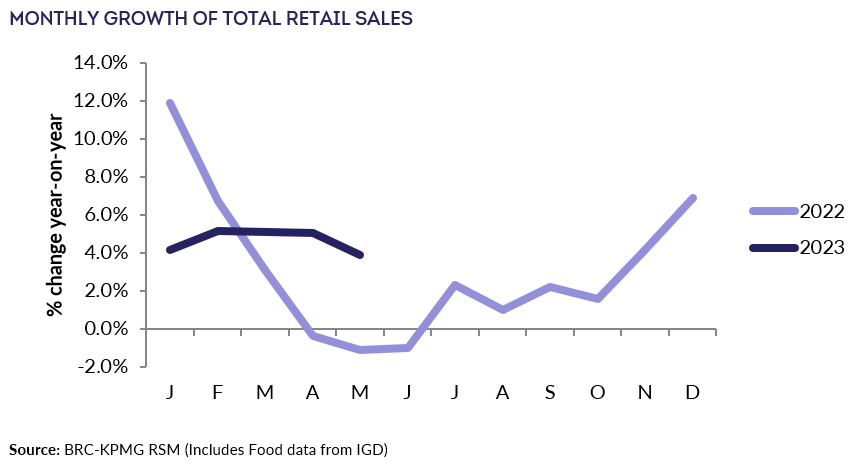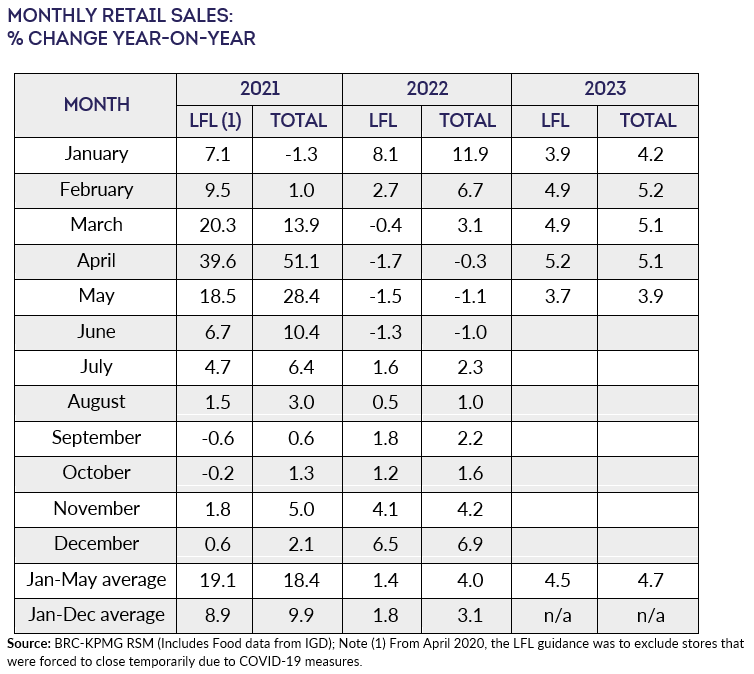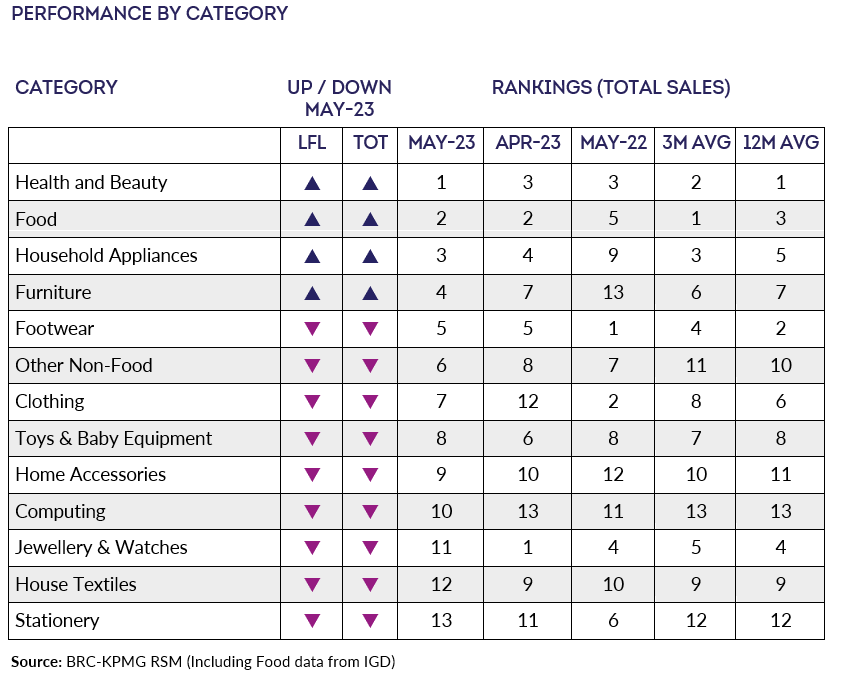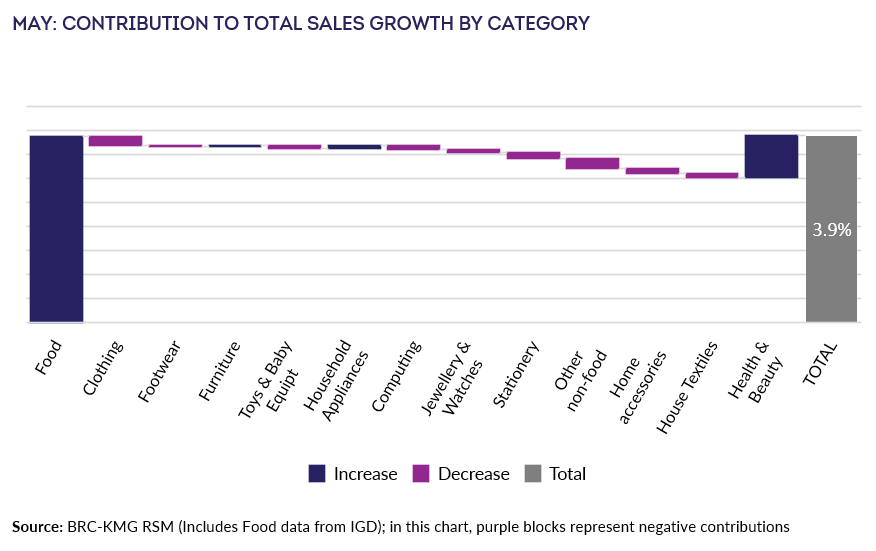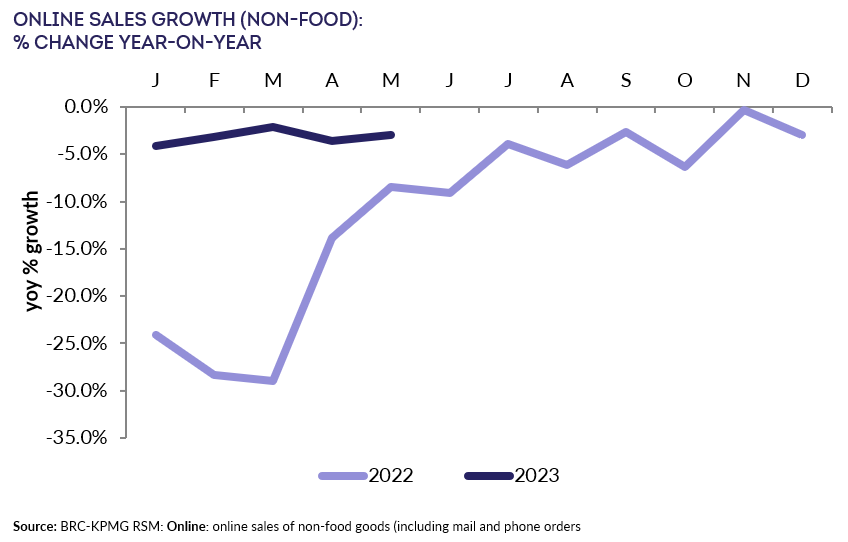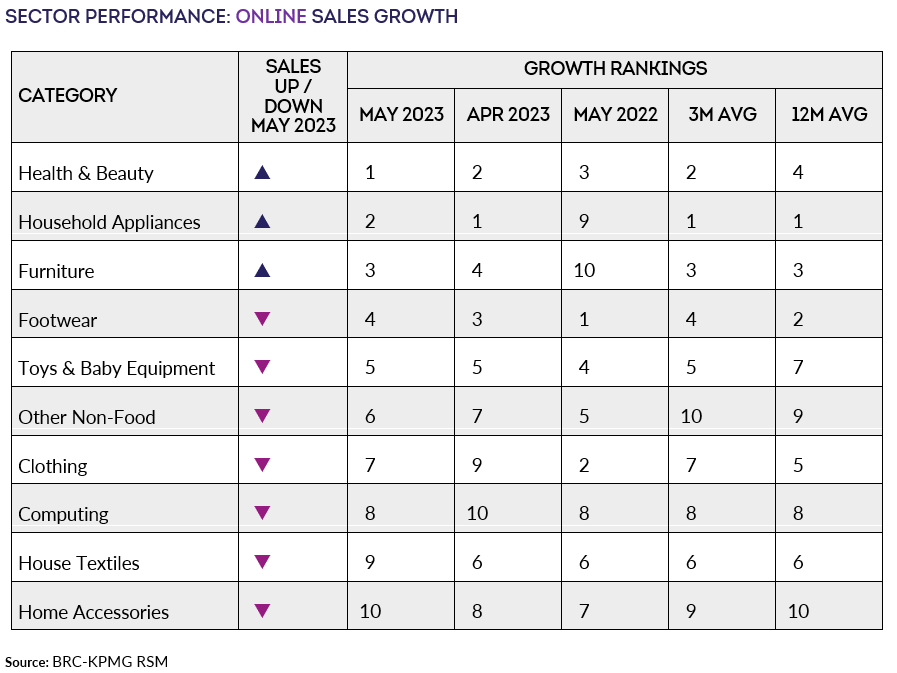Sales figures are not adjusted for inflation. Given that both the
May SPI (BRC) and April CPI (ONS) show inflation running at
historically record levels, the rise in sales masked a much
larger drop in volumes once inflation is accounted for.
Covering the four weeks 30 April – 27 May
2023
-
UK Total retail sales
increased by 3.9% in May, against a decline of 1.1% in May
2022. This is below the 3-month average growth of 4.7% and
above the 12-month average growth of 3.4%.
-
UK Like-for-like retail sales increased by
3.7% in May, against a decline of 1.5% in May 2022. This was
below the 3-month average growth of 4.6% and above the 12-month
average growth of 3.1%.
-
Food sales increased 9.6% on a Total basis and
9.8% on a Like-for-like basis over the three months to May.
This is above the 12-month Total average growth of 6.9%. For
the month of May, Food was in growth year-on-year.
-
Non-Food sales increased 0.7% on a Total basis
and 0.5% on a like-for-like basis over the three-months to May.
This is above the 12-month Total average growth of 0.5%. For
the month of May, Non-Food was in growth year-on-year.
- Over the three months to May, In-store Non-Food
sales increased 2.9% on a Total basis and 2.2% on a
Like-for-like basis since May 2022. This is below the Total
12-month average growth of 3.7%.
-
Online Non-Food sales decreased by 3.0% in
May, against a decline of 8.5% in May 2022. This is steeper
than the 3-month average decline of 2.8% and shallower than the
12-month decline of 4.0%.
- The proportion of Non-Food items bought online (penetration
rate) decreased to 36.3% in May from 37.1% in May 2022.
Helen Dickinson OBE, Chief Executive | British Retail
Consortium
“The trio of bank holidays failed to get
shoppers spending as sales growth slowed to its lowest level in
six months. While food sales got a boost from the Coronation
weekend, this was not sustained for the rest of the month.
Meanwhile, growth in discretionary spend continued to tumble as
the high cost of living squeezed households. There was cause for
some optimism, however, as brighter weather at the end of the
month led to a much-needed pick-up in summer fashion sales, as
well as gardening and DIY products.
“With consumer confidence still recovering from record depths,
and continued tightening of household incomes, we are unlikely to
see substantial sales growth in the coming months. But, with
signs that inflation has possibly peaked, retailers are hopeful
that confidence will continue to improve. Now is not the time for
Government to impose more regulation and tax on business that
will push up costs for retailers and prices for their customers.”
, UK Head of Retail |
KPMG
“Despite warmer weather, a national
celebration and month of bank holidays, retailers saw pretty mild
growth in May with sales figures up just 3.9% on last year, and
lower than the 5% growth seen in April.
“High street retailers saw more categories slip into negative
sales territory last month, with health, beauty and food driving
sales on the high street. The gloom continued for online
retailers with just four categories registering positive sales
figures and total sales down by 3%. Online penetration
rates continued to slide, sitting at 36%, as consumers return to
bargain hunting in store.
“Retailers will be hoping that inflation levels in the wider
economy continue to move in the right direction in order to boost
much needed consumer confidence. The wild card for the
retail sector remains uncontrollable food inflation, which shows
little sign of coming down in the near future, and this is having
a significant knock-on effect on non-essential spending.
The grocery sector is the fastest growing part of the consumer
wallet at the moment, so consumers are having to spend more of
their money in the one area that is getting disproportionately
more expensive.
“UK consumers are resilient, but with stubbornly high food
inflation continuing and the prospect of further interest rate
rises threatening to impact their ability to spend elsewhere, it
is likely to be a long, hot summer for the retail sector.”
Food & Drink sector performance | Susan Barratt, CEO
| IGD
“May’s food and drink sales again saw strong value growth, with
double-digit inflation driving sales consistently over the
four-week period. Volume sales were marginally negative, even
with a brief uptick from the events surrounding the Coronation of
King Charles.
“Despite food price inflation reaching its highest level for 45
years in the first quarter of 2023, shoppers overall seem
slightly less fearful about how high prices will go. Although
three-quarters (75%) expect food prices to get more expensive in
the year ahead, this is actually the lowest level since July
2021, and IGD’s Shopper Confidence Index continued to improve in
May to reach its highest level in more than two years. At the
same time, the number of shoppers expecting to be better off
financially in the year ahead has risen, up from 14% this time
last year to 18%.”
